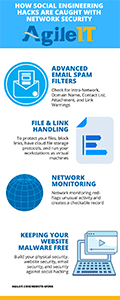How Social Engineering Hacks Are Caught With Network Security
Social engineering is by far the most insidious type of hack to ever be used against a business The worst part is that hackers arent even pitting th...

Social engineering is by far the most insidious type of hack to ever be used against a business. The worst part is that hackers aren’t even pitting their advanced computer skills against the firewalls and protections of a company’s network security. Instead, they are targeting employees, trying to use con-artist tricks to fool authorized staff into giving them access.
Social engineering hacks have claimed to be the target’s boss, colleague, sick grandmother, and best friend. They will use any identity or lie they can think of to fool employees with legitimate access into exposing the company network or company secrets. Fortunately, their tactics are not as versatile. To “phish” (the hacker term for social engineering), a hacker must first send a message. And in that message, a well-designed network security defense can often catch the signs of a social hack before an employee has a chance to click.
The 3 Ways Network Security Fights Phishing
- Advanced Email Spam Filters
- Safe File and Link Handling
- Configured Network Monitoring
Advanced Email Spam Filters
 Click to view infographic
Click to view infographic
Email spam filters originally protected professional inboxes from Viagra adverts and unwanted newsletters. Usually, they check for spammy content like overuse of capital letters, large fonts, and flashy images. However, over time, the filters used on professional email servers have evolved to include protections against social engineering as well.
If you are using the correct software and have it configured for your network, then an email spam filter can help you stop phishing messages in their tracks. Before they have a chance to fool an employee who is just trying to do their job.
Intra-Network Check
The first type of check a business email filter can do is check to see if it came from inside the network or outside. An internal email server doesn’t have to route emails out into the world wide web to send a message from one employee to another. And internally-sent messages are much more likely to be safe than anything that comes in from the outside.
For a team member who deals almost exclusively with intra-network messages sent to and from other in-building employees, an external email can be given a yellow-flag, a quick heads-up that the message is not internally employee-to-employee. If the message claims to be from an internal coworker, this flag automatically marks it as a fraud.
Domain Name Check
For judging emails from the outside, the process gets a little more complex. The next step is to check the domain name of the sender. (ex: @mydomain.com) It does this in two ways.
First, your email filter can check a sender domain against a universal blacklist of known hacker domain names. If it’s from a known black-hat domain, then a red-flag and potential block are automatically applied to the email. Employees are alerted they have received a malicious email and not to open it. Alert IT as well.
Email filters can also check to see if a sender’s domain name has suspicious features. For example, if it is a misspelled variation (a common hacker trick) of a popular domain name, or a variation of a domain that the employee interacts with regularly. When this is true, an orange-flag warning goes up, letting employees know that they might be dealing with a spoofed email and hacking attempt.
Contact List Check
Next, your email filter will check to see if the sender is on the contacts list. Contact lists come in three forms for employees:
- Company contact list consisting of all company employee and business partner email addresses
- CRM contact list consisting of all customers and leads
- The employee’s personal contact list consisting of all email addresses they have messaged with previously
If an email is not on any of the three contact lists, the spam filter will yellow-flag it to let employees know that they are dealing with a new person, even if the email claims to be (and appears to be) from a known contact. If the filter detects a name similar to a contact, it may upgrade to an orange or red flag for potential spoofing attempts.
Attachment and Link Warnings
Finally, an email spam filter will generally give a warning any time an email contains a link or attachment. This is to cause employees to think twice about trustworthiness before clicking anything potentially infectious.
File & Link Handling
After the email filter is file and link handling. The primary way that hackers use social engineering is to trick employees into opening malicious files or links that expose the workstation and internal business network to malware downloading and attacks. Naturally, network security assists employees in safely handling every single file and link. Thus, a malicious one cannot slip through.
Link Blocking
A good protective system automatically blocks links that go somewhere untrustworthy. Like domain names, your filter can start with the list of known hackers or hacked sites. From there, anything that requires too many redirects or does not go where the link says it goes can be blocked for safety. Your business can also put together a specific blacklist or block all email-links by default. Requiring employees to copy-paste the link which requires an extra layer of intentional action and decision-making.
Cloud File Storage Protocols
For email attachments, it’s best never to allow employees to download directly to their workstations. With good network security, your entire company should be using a cloud file storage system that allows employees to download files to a well-defended cloud file server and view files remotely rather than locally. A file server service prepares to isolate and handle malicious downloads, and your business network will be kept safe.
Virtual Machines
An interesting and highly effective alternative is to have your employees run their workstations as virtual machines: virtual operating systems that can be closed, wiped, and restarted fresh much more easily than factory-resetting a computer. This way, even if an employee does manage to download malware, the entire operating system it is connected to can be scrapped and rebuilt without effect. Just be careful about network connections while using virtual machines, as your network can potentially still be exposed.
Network Monitoring

Finally, never underestimate the power of well-managed network monitoring. Network monitoring covers all the bases, watching everything from server core temperatures to the Bytes of data flowing through your network. Network monitoring watches everything about your company computers, intranet, and connection to the internet. Ports, transferred data, even the motherboard temperatures of each computer can be monitored, tracked and logged. With managed network monitoring, you’ve got a window into everyday processes and an alert system for unusual activity.
Red-Flags Unusual Activity
So, any suspicious activity including unusually timed logins, money transfer, or file access can be flagged with helpful warnings. Then, send both to the acting employee (ex “You don’t normally access this file. Please double-confirm before continuing”) and the IT department (ex “A sensitive file is being accessed by an unusual employee. This might be hacking”). Network monitoring is great for catching everything that might otherwise slip through the cracks between other network security software.
Creates a Checkable Record
Even if initial activity is not noted or flagged, network monitoring is usually designed to create an ongoing log and record that can be checked if a problem is detected. If someone appeared to be on your company network legitimately but came through the wrong port or had a stolen login, there will be a record. This record can be checked, cross-referenced, and verified to not only catch social hackers, but prevent their avenues of attack in the future both socially and technically.
Keeping Your Website Malware-Free
Building a company and a website that can be kept malware-free is a huge task. Build security from the ground up, starting at the lowest layer of connection up through the cloud. You need physical security, website security, email security, and of course security against social hacking as well.
Are your employees vigilant against phishing and social engineering hacks? While you can trust great training and regular cybersecurity drills to keep your team on their toes, a few layers of network security to help them is always a good idea. From email warnings to virtual machines, your network security infrastructure really can help employees protect themselves from social engineering hacks.
A well-practiced website built on powerful technology and a whole-team game plan is your best defense. Train your team to be suspicious of communications, to watch out for phishing and trolling, and to respect the technical protections you put into place. From there, you can trust our team to build you an incredible (and incredibly secure) website from which you can run your online business empire.
Conclusion
Cybersecurity is a huge issue in modern business, and it’s not just a once-facet concern anymore. Cybersecurity isn’t just about firewalls and data control. It’s also about web security and social hacking defenses as well. Let us help you build an amazing website that is both enjoyable and secure enough to win customer loyalty. Contact us for more business security insights.





